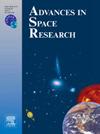利用粒子群优化器进行光曲线姿态估计
IF 2.8
3区 地球科学
Q2 ASTRONOMY & ASTROPHYSICS
引用次数: 0
摘要
在空间态势感知中,了解空间物体的姿态有助于独立评估卫星的健康状况和未知物体的特征。在只有非分辨光学观测数据的情况下,可以使用亮度观测数据的时间序列(也称为光曲线)来估计物体的姿态。这种姿态估计问题存在多种困难:即使在没有噪声和所有其他相关因素都完全已知的情况下,该问题的非唯一性也意味着多个姿态时间历程可能同样适合光曲线。此外,通常没有足够的天体信息来生成估计器的初始状态猜测。本文提出了一种方法,在考虑模糊性的同时,无需任何初始状态猜测即可估算出观测物体的姿态和角速度。唯一的输入是光曲线、天体的反照率形状以及天体相对于太阳和观测者的位置。通过将状态估计值与已知的真实状态进行比较,利用模拟光曲线演示了估计器解析姿态时间历程的能力。本文章由计算机程序翻译,如有差异,请以英文原文为准。
Light curve attitude estimation using particle swarm optimizers
Knowledge of the attitude of a space object is useful in space situational awareness for independently evaluating a satellite’s health and characterizing unknown objects. In cases where only non-resolved optical observations are available, the object’s attitude may be estimated using a time sequence of brightness observations, also known as the light curve. This attitude estimation problem is plagued with multiple difficulties: even in the absence of noise and when all other relevant factors are perfectly known, the non-uniqueness of the problem means that multiple attitude time histories may fit the light curve equally well. In addition, there is often insufficient information about the object to generate an initial state guess for an estimator. This paper presents a method that estimates an observed object’s attitude and angular velocity while accounting for ambiguities and without needing any initial state guess. The only inputs are the light curve, the object’s albedo shape, and the object’s position relative to the Sun and the observer. The ability of the estimator to resolve attitude time histories is demonstrated using simulated light curves by comparing state estimates against known true states.
求助全文
通过发布文献求助,成功后即可免费获取论文全文。
去求助
来源期刊

Advances in Space Research
地学天文-地球科学综合
CiteScore
5.20
自引率
11.50%
发文量
800
审稿时长
5.8 months
期刊介绍:
The COSPAR publication Advances in Space Research (ASR) is an open journal covering all areas of space research including: space studies of the Earth''s surface, meteorology, climate, the Earth-Moon system, planets and small bodies of the solar system, upper atmospheres, ionospheres and magnetospheres of the Earth and planets including reference atmospheres, space plasmas in the solar system, astrophysics from space, materials sciences in space, fundamental physics in space, space debris, space weather, Earth observations of space phenomena, etc.
NB: Please note that manuscripts related to life sciences as related to space are no more accepted for submission to Advances in Space Research. Such manuscripts should now be submitted to the new COSPAR Journal Life Sciences in Space Research (LSSR).
All submissions are reviewed by two scientists in the field. COSPAR is an interdisciplinary scientific organization concerned with the progress of space research on an international scale. Operating under the rules of ICSU, COSPAR ignores political considerations and considers all questions solely from the scientific viewpoint.
 求助内容:
求助内容: 应助结果提醒方式:
应助结果提醒方式:


